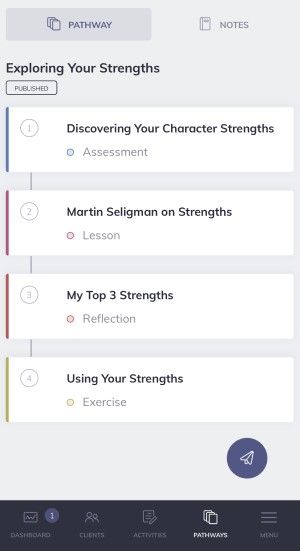 character strenghts assessments" width="300" height="150" />
character strenghts assessments" width="300" height="150" /> character strenghts assessments" width="300" height="150" />
character strenghts assessments" width="300" height="150" />
Character strengths are an indispensable aspect of positive psychology.
They are a collection of personal abilities that buffer against mental health disorders and positively impact our overall health and wellbeing (Bromley, Johnson, & Cohen, 2006).
The concept of character strengths stems as far back as the 1920s, and research on the topic has amplified globally. Many character strengths tests and assessments, both qualitative and quantitative, have emerged to help mental health professionals evaluate individual strengths and weaknesses.
Given the growing number of such tests, it can be challenging to know which assessments are sufficiently reliable and valid.
This article will explore three of the most scientifically backed character strengths assessments to help you choose the best assessment for your psychology or coaching practice.
Before you continue, we thought you might like to download our three Strengths Exercises for free. These detailed, science-based exercises will help you or your clients realize your unique potential and create a life that feels energized and authentic.
There are two key ways we can evaluate a person’s strengths, each of which has pros and cons. One approach is to use qualitative methods, while the other is to use quantitative methods.
Qualitative approaches to understanding someone’s strengths can be carried out with the support of a coach, consultant, or therapist. Such explorations can be conducted one-on-one or in a group setting, such as within a work team.
A popular approach to conducting qualitative strengths assessments is through observation or retrospective reports from observers, such as by using the critical incident technique (Flanagan, 1954).
Flanagan (1954, p. 327) defines an incident as “any observable human activity that is sufficiently complete in itself to permit inferences and predictions to be made about the person performing the act.”
When using the critical incident technique, researchers will effectively collect ‘stories’ of incidents that can be taken to be reflective of a person’s character, or in this case, a person’s character strengths.
For instance, imagine you were reflecting on what you felt to be your best friend’s character strengths. In doing this, you might recall a time when this person dropped their plans to come to your aid on short notice, such as if a pipe burst in your home and this person came to help mop up the water in your house.
This situation involving your friend’s actions in light of the burst pipe is an example of a critical incident that you might take to indicate a character strength such as dependability or generosity.
There are several advantages to using qualitative methods, particularly the critical incident technique, to gauge a person’s character strengths (MBA Skool Team, 2020).
First, the technique allows for the identification of strengths that may only manifest in unique or heightened situations. For instance, it’s not every day that you need a friend to rush to your aid, as in the example above. However, had we only assessed this friend’s strengths based on their behavior on an average day, we may never have become aware of their dependability and generous spirit.
Another strength of qualitative approaches is that they can account for the role and perspective of the observer, as well as the context in which a strength is demonstrated.
For example, while an interview with a work acquaintance may reveal work-related behaviors that point to their colleague’s strengths, such as perseverance, the romantic partner of that colleague may observe different strengths, such as empathy. Qualitative approaches can tap into both sources’ perspectives simply by interviewing these different observers.
Finally, the critical incident approach allows for the identification of more unusual or niche character strengths that do not necessarily fit into an existing framework. Examples of such strengths may include wittiness or eye for detail. Furthermore, sometimes these initial qualitative observations can aid in the development of a quantitative measure of character strengths later down the line (Thun & Kelloway, 2011).
Despite these advantages, qualitative approaches to assessing character strengths have several downsides (MBA Skool Team, 2020).
First, observations made by others are subject to memory and recall biases (Michel, 2001). While this is also true of quantitative reports of strengths gathered from observers, the critical incident approach may exacerbate this effect.
Second, qualitative reports via the critical incident approach may be vulnerable to recency effects. That is, observations that have been made closer to the time of reporting may crowd out those that occurred further in the past.
Finally, depending on the person, situation, and context, basing an assessment of character strengths purely on critical incidents may not be an accurate reflection of that person’s strengths. For instance, the character strength of social intelligence is a strength that may manifest passively and subtly in a person’s daily interactions, rather than in heightened situations.
For a resource containing many qualitative examples of character strengths, take a look at Ryan Niemiec and Robert McGrath’s book The Power of Character Strengths: Appreciate and Ignite Your Positive Personality.
In this book, you’ll find over 50 examples of stories highlighting people’s character strengths and virtues being carried out in everyday life.

Quantitative approaches to exploring our strengths usually take the form of self-report questionnaires.
However, they can sometimes involve responses to questionnaires completed by others on our behalf, such as those involved in 360-degree assessments.
As with qualitative character strengths assessments, these sorts of questionnaires based on psychometrics have a range of strengths and weaknesses.
First, quantitative character strengths-based interventions and tools are becoming increasingly convenient to administer as part of a coaching or counseling practice using digital tools.
For instance, using a platform such as Quenza, helping professionals can easily channel clients through a pathway of self-paced activities that assess and explore character strengths using standardized questionnaires or exercises.
Second, standardized measures of strengths and weaknesses tend to yield more accurate and objective assessments of character strengths than qualitative assessments.
As we’ve seen, qualitative assessments can be biased by recall, recency effects, context, and the perspective of the person providing the assessment. In contrast, quantitative assessments tend to produce results that exhibit test–retest reliability (Peterson & Seligman, 2004). That is, a person taking the same test at a later point in time will tend to get a similar result.
However, like qualitative assessments, quantitative assessments of character strengths have downsides, too.
First, quantitative assessments may be vulnerable to socially desirable responding. For example, Osin (2009) found that various character strengths in Peterson and Seligman’s (2004) Values in Action model correlate significantly with indicators of socially desirable responding, such as the strengths of honesty, modesty, and forgiveness.
Therefore, it is important to be wary of using these sorts of questionnaires in contexts where people are motivated to respond in a way that makes them appear favorable, such as in selection and hiring scenarios.
Organizations should be especially careful to confirm that there are, indeed, links between particular strengths and desirable work behaviors/performance before incorporating such tests in any sort of selection or evaluation process.
Second, quantitative indicators of character strengths tend to adopt a one-size-fits-all approach and are, therefore, limited to the lists of strengths, domains, or factors included in the assessment.
Consequently, these assessments may fail to capture more niche or unusual strengths.
Finally, it can be challenging to choose an appropriate scale with adequate scientific backing (although this post should help with this!), and some scales require certification to be administered properly.
Ultimately, as a practitioner, the best approach you can take to assess strengths will probably involve a combination of qualitative, face-to-face discussion, and quantitative psychometrics. However, given the accessibility and ease with which such psychometrics can be administered, there is little reason not to incorporate them into your strengths-based coaching practice.
Next, we’ll take a closer look at three character strengths assessments that have exhibited robust evidence of reliability and validity throughout research and are widely used in practice.

If you’re looking for the leading assessment on character strengths, look no further than the VIA Character Strengths Survey, designed by Christopher Peterson and Martin Seligman (2004).
In their research, Peterson and Seligman view character strengths as “specific psychological processes that define broader virtues, which are core characteristics that have been identified and valued by moral philosophers and religious thinkers throughout time” (Shogren, Singh, Niemiec, & Wehmeyer, 2017).
This 15-minute assessment measures 24 such character strengths, which fall under six overarching categories:
| Signature strength | Meaning |
|---|---|
| Wisdom and knowledge | |
| 1. Creativity 2. Curiosity 3. Judgment 4. Love of learning 5. Perspective | 1. The ability to develop something unique and original. 2. Inquisitiveness and interest to know. 3. The power of rationalization and critical thinking. 4. The affinity to participate in new activities to adapt to something new. 5. Wisdom and perception to see the world as others see it. |
| Courage | |
| 1. Bravery 2. Perseverance 3. Honesty 4. Zest | 1. Courage, valor, fearlessness. 2. Persistence and the power to hang on during times of distress. 3. Genuineness, truthfulness, and authenticity. 4. The energy to live life fully and face challenges with grit and positivity. |
| Humanity | |
| 1. Love 2. Kindness 3. Social intelligence | 1. The power to feel and show affection to others and develop long-lasting relationships. 2. Mercifulness and empathy. 3. The ability to communicate effectively and form strong social bonds. |
| Justice | |
| 1. Teamwork 2. Fairness 3. Leadership | 1. The motivation to work as part of a team and strive to achieve group goals. 2. The virtue of treating everyone equally and making unbiased judgments. 3. The capacity to be the face of a team, supervise effectively, and empower others. |
| Temperance | |
| 1. Forgiveness 2. Humility 3. Prudence 4. Self-regulation | 1. The ability to accept others’ shortcomings. 2. Modesty and a humble nature. 3. Rational thinking and the power to interpret things logically. 4. Control over oneself and command over self-expression. |
| Transcendence | |
| 1. Appreciation 2. Gratitude 3. Hope 4. Humor 5. Spirituality | 1. Praising the self and surroundings. 2. Feeling and expressing thankfulness, including for the small things in life. 3. Positive, future-oriented feelings and optimism. 4. The ability to approach life with a playful, light attitude. 5. Religious faithfulness and commitment. |
The VIA assessment consists of a total of 240 positively keyed questions. Examples of items include “I experience deep emotions when I see beautiful things” and “I always treat people fairly whether I like them or not.”
All items are presented on five-point scales, where 1 is ‘very much like me,’ and 5 is ‘very much unlike me.’
You can complete the full VIA assessment for free at the VIA Institute on Character’s website.
This strengths classification scheme and assessment marks the culmination of a three-year research project led by Peterson and Seligman (2004) involving 55 social scientists from around the world (VIA Institute on Character, n.d.).
All 24 subscales have exhibited satisfactory internal consistency. This means that the items assessing each strength appear to effectively contribute to the measurement of that strength.
Likewise, test–retest correlations for the scale over a four-month period are substantial, suggesting that the questionnaire tends to produce consistent scores for the same individual across time.
The test also exhibits convergent validity with a range of demographics. For instance, military personnel taking the test were significantly more likely than civilians to return high scores on the strengths of honesty, hope, perseverance, and teamwork.
Despite these positive findings, one study revealed that the 24 character strengths did not produce a factor structure consistent with the six higher order factors proposed by Peterson and Seligman (Macdonald, Bore, & Munro, 2008), suggesting potential issues with the conceptual theory underlying the assessment.
However, despite these findings regarding factor structure, the VIA appears to be an effective and psychometrically valid tool that is likely to find a home in any positive psychologist’s toolkit.

These detailed, science-based exercises will equip you or your clients with tools to discover and harness their unique strengths.